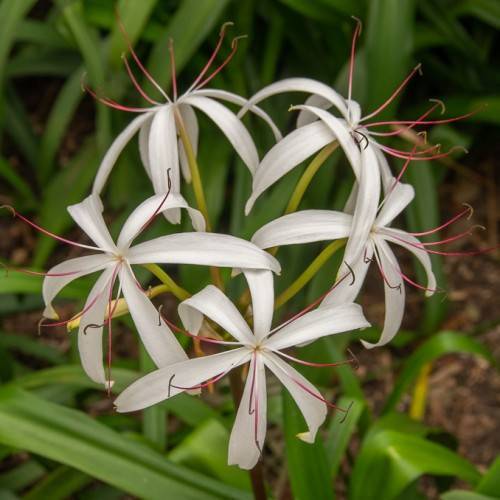
crinum
Crinum (group)
Cycle:
Perennial
Watering:
Average
Hardiness Zone:
8 - 10
Flowers:
Flowers
Sun:
Full sun,part shade
Leaf:
Yes
Growth Rate:
High
Maintenance:
Moderate
Salt Tolerant:
Yes
Care Level:
High
watering
Crinum plants should be watered regularly and evenly. For best results, water your crinum plants early in the morning. This allows the leaves and soil to dry out faster, preventing them from getting too wet and promoting better root health. Water your crinum plants until the soil is thoroughly moist but not flooded. Allow the top inch or so of soil to dry out before watering again. The exact amount of water will depend on the size of the container and the ambient temperatures; when it's hot, you will need to water more often. During cooler months, water your crinum less often. If the soil remains bone dry for more than a week, then give the plant a good drink.
sunlight
Crinum plants prefer full sun exposure and will thrive in areas that receive 5 to 6 hours of direct sunlight each day. The ideal temperature for crinum plants is between 65 and 85 degrees Fahrenheit. Additionally, crinum plants require moist, well-drained soil. For optimal growth, the soil should be supplemented with a slow-release fertilizer. Crinum are not tolerant of cold temperatures, so if you live in an area with temperatures that dip below freezing, they must be stored indoors during the colder months.
pruning
Crinum (group) plants need to be pruned regularly to keep them healthy and prevent them from becoming overgrown. Generally, it is recommended that you prune crinum every 1-2 years in late winter or early spring. The best time to prune crinum is when the plant is dormant, right before the new growth begins in springtime. Begin by removing any broken or dead leaves or stems. Then, look closely at the fan of leaves at the base of the plant. Trim away any leaves that are discolored or have brown spots. This will help to open up the plant for new and healthy growth. Continue by pruning away any stems that have become overgrown or are misshapen. You can also prune any stems that are longer than your desired shape to help keep the plant looking neat and healthy. Lastly, if there are any flowers on the plant, prune them away before they turn brown to encourage future flowering. Remember to always use sharp and sterilized pruning tools to get the best results and minimize damage to the plant.
